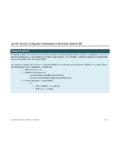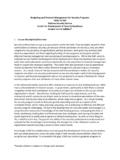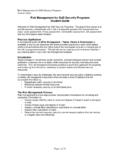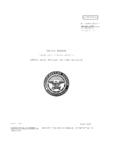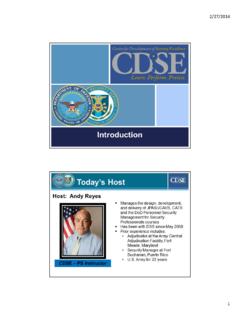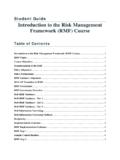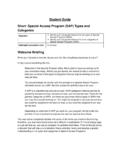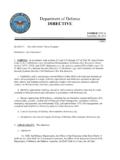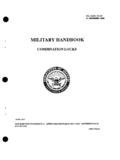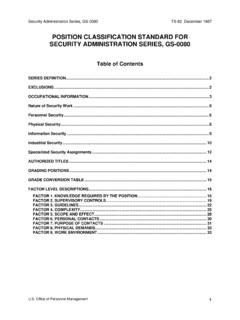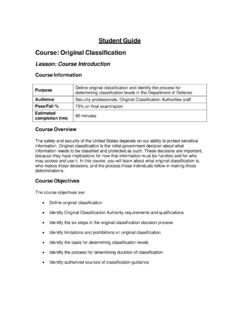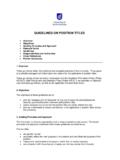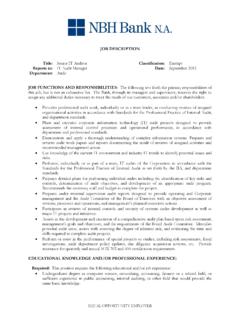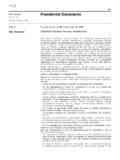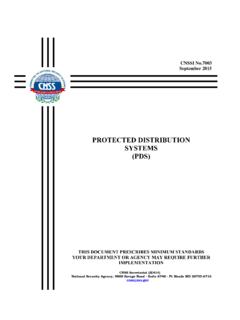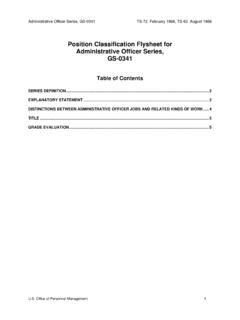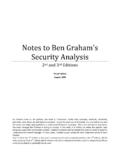Transcription of Security Classification Guidance v3 Student Guide …
1 Security Classification Guidance v3 Student Guide September 2017 Center for Development of Security Excellence Security Classification Guidance v3 Student Guide September 2017 Center for Development of Security Excellence Page 1-1 Lesson 1: Course Introduction Course Overview Welcome to the Security Classification Guidance Course. The safety and Security of the United States depends on the ability to adequately protect classified information. When an Original Classification Authority ( OCA) determines that information must be classified, he or she must also develop Security Classification Guidance to communicate that determination to others.
2 Developing clear and precise Security Classification Guidance is critical because it ensures that all users of the information treat it consistently and protect it properly. In this course, you will learn about the process of developing Security Classification Guidance ; that is, the policy documents that govern its creation, the different types of Guidance , the Classification determination itself, and specifically, how to develop each type of Guidance , including declassification guides. Course Objectives Here are the course objectives: Identify the policy documents that govern the development of Security Classification Guidance Identify the types of Security Classification Guidance Identify the Classification determination process Identify the principles of developing Security Classification Guidance Identify the process of developing declassification Guidance Course Structure This course is organized into the lessons listed here.
3 Course Introduction Security Classification Guidance Overview Classification Guidance Development Process Developing Security Classification Guidance Developing Declassification Guidance Course Conclusion Security Classification Guidance v3 Student Guide September 2017 Center for Development of Security Excellence Page 2-1 Lesson 2: Security Classification Guidance Overview Introduction It is vital in the protection of our national Security to properly develop Classification Guidance and communicate the decisions. This Guidance can come in different forms, but all of them facilitate comprehensive, relevant, and concise Classification Guidance by authorized officials.
4 They are issued to communicate Classification determinations effectively and efficiently. In this lesson, you will learn the definition and purpose of Security Classification Guidance , the policy documents that govern its development, and the different types of Classification Guidance . Lesson Objectives Identify the purpose of Security Classification Guidance Identify the policy documents that govern the development of Security Classification Guidance Identify the types of Security Classification Guidance Security Classification Guidance Purpose Security Classification Guidance is any instruction or source that sets out the Classification of a system, plan, program, mission, or project.
5 It is initially issued by Original Classification Authorities ( OCAs) to document and disseminate Classification decisions under their jurisdiction. The purpose of Security Classification Guidance is to communicate Classification decisions, promote uniform derivative Classification and consistent application of Classification decisions to all users of the relevant information. This is critical to ensure all users of the information are applying the same level of protection, for the same information, and for the same duration. Finally, it helps ensure that classified information receives the required level of protection when making derivative Classification decisions.
6 National Policy The foundation of national policy for classified information is Executive Order 13526, Classified National Security Information. This Executive Order prescribes a uniform system for classifying, safeguarding, and declassifying national Security information, including information that relates to defense against transnational terrorism. The Executive Order Security Classification Guidance v3 Student Guide September 2017 Center for Development of Security Excellence Page 2-2 directs the Information Security Oversight Office ( ISOO) under the direction of the National Archives, to develop implementing Guidance .
7 They issued ISOO, 32 CFR Parts 2001 and 2003, Classified National Security Information; Final Rule, which sets forth more specific Guidance to agencies on the implementation of the Executive Order. It addresses Security Classification Guidance . Based on this national policy, the Department of Defense (DoD) has issued its own implementing Guidance . Let's take a closer look. DoD Policy The DoD has implemented national policy Guidance on classified information in several documents. DoD Instruction , DoD Information Security Program and Protection of Sensitive Compartmented Information (SCI) establishes the general framework and responsibilities for DoD implementation of national policy on classified national Security information.
8 It authorizes the publication of DoD Manual , Volume 1 through 4, DoD Information Security Program, which prescribe the defined procedures for the DoD Information Security Program. This manual contains the requirements and minimum standards for developing Classification Guidance . Another key DoD resource for developing Security Classification Guidance is DoDM , Instructions for Developing Security Classification Guides. This manual provides detailed information on how to develop Security Classification Guidance . All of these DoD resources address the protection of classified information at the Confidential, Secret, and Top Secret levels.
9 In addition to classified information, controlled unclassified information ( CUI) requires protection. Controlled Unclassified Information (CUI) The DoDM contains policies and procedures for the DoD implementation of the Freedom of Information Act ( FOIA). It identifies nine categories of information that may be withheld from public release. Classified National Security Information is protected by exemption one. Information that is determined to be CUI and falls under exemptions 2 through 9may have special safeguarding and handling requirements. These requirements are identified in DoDM , Volume 4.
10 Types of Guidance Overview There are three authorized methods used to communicate Classification decisions. They are, in order of preference, a Security Classification Guide (SCG) a properly marked source document, and DD Form 254, the DoD Contract Security Classification Specification. This course will address developing all three types of Guidance . Let s look at each one in more detail. Security Classification Guidance v3 Student Guide September 2017 Center for Development of Security Excellence Page 2-3 OCA An original Classification authority (OCA) is a senior government official who is granted the authority to make an initial determination that information requires protection against unauthorized disclosure in the interest of national Security .
